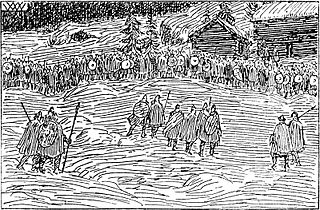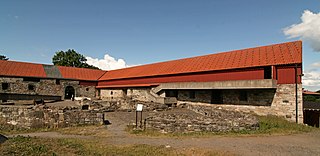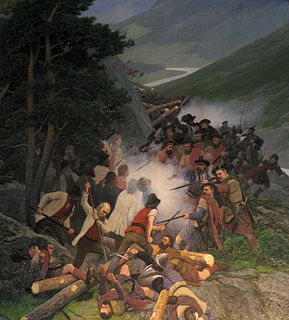 W
WThe Battle of Anglesey Sound was fought in June or July 1098 on the Menai Strait, separating the island of Anglesey from mainland Wales. The battle was fought between Magnus Barefoot, King of Norway, and the Anglo-Norman earls Hugh of Montgomery and Hugh d'Avranches, and took place as part of Magnus Barefoot's expedition into the Irish Sea, which sought to assert Norwegian rule over the Kingdom of the Isles.
 W
WThe Battle of Oslo was fought outside of Oslo on the night of 3 February 1161 between Haakon II of Norway and Inge I of Norway during the civil war era in Norway. As the son of Ingiríðr Ragnvaldsdóttir and king Harald Gille, Inge had been named king of Norway after Gille was killed by Sigurd Slembe. His two half-brothers, Magnus and Sigurd, were also named kings around the same time, and the three ruled Norway. By 1157, Inge's brothers were both dead, and he was the sole remaining ruler of Norway. Haakon II, an illegitimate son of Gille, then contested Inge's rule, and at the Battle of Oslo Inge was killed. According to the Heimskringla, Inge had 4,800 men.
 W
WThe Battle of Bysjön was fought between Swedish and, for the most part, Norwegian troops on 22 December 1644. The battle took place on the ice of the frozen Lake Bysjön in the parish of Eda in Värmland, Sweden. The battle was part of the Torstenson War (1643-1645), known locally as the Hannibal Feud (Hannibalsfejden) between Sweden and Denmark-Norway. The Danish-Norwegian victory meant the invading army could potentially continue into Värmland and Dalsland.
 W
WThe naval Battle of Dynekilen took place on 8 July 1716 during the Great Northern War.
 W
WThe Battle of Fulford was fought on the outskirts of the village of Fulford near York in England, on 20 September 1066, when King Harald III of Norway, also known as Harald Hardrada, and Tostig Godwinson, his English ally, fought and defeated the Northern Earls Edwin and Morcar.
 W
WThe Battle of Hafrsfjord was a great naval battle fought in Hafrsfjord sometime between 872 and 900 that resulted in the unification of Norway, later known as the Kingdom of Norway. After the battle, the victorious Viking chief Harald Fairhair proclaimed himself the first king of the Norwegians, merging several petty kingdoms under a single monarch for the first time.
 W
WThe Siege of Hamar was a short siege that lasted for three days in late June 1537, between the forces of Catholic bishop Mogens Lauritssøn and noble Truid Ulfstand. Truid Ulfstand and his forces came down from Trondheim to arrest the bishop as a part of the Reformation in Denmark–Norway and Holstein. The bishop heard that he was going to be arrested and barricade himself and his men inside his farm at Hamar before the Protestant troops came. The Protestant troops where superior both in numbers and military tech, and when the Protestant troops arrived they laid siege to the farm. The commander of the Protestant forces had a parley with the bishop, and gave him three days to surrender or he would burn the farm. On the third day of the siege the bishop surrendered and was taken as a prisoner to Denmark, where he died in 1542.
 W
WThe Battle of Kjølberg Bridge was fought 14 August 1814, during the Swedish–Norwegian war of 1814. The Swedish army had problems repairing the bridge due to constant fire from the Norwegian side of the river. It was then a small Swedish force of 75 men, consisting of jägers from the Bohuslän and Life Grenadier Regiments, passed over the river at a hidden point. Once over they waited for reinforcements but none came; but instead the order of attacking the vastly larger Norwegian force. The Colonel response to the attack order have been famous "It is unreasonable to attack with only 75 men when you face a whole regiment." "But such an order isn't given to me twice. March!" During cheers the Swedes rushed up the hill toward the mansion that was occupied with 600 men. The attack was surprising and decisive. As more Swedish troops crossed, the Norwegians quickly left the stand. This was the last battle fought during the Swedish–Norwegian War. The Convention of Moss, providing a cease fire agreement, was signed that same day.
 W
WThe Battle of Kringen involved an ambush by Norwegian peasant militia of Scottish mercenary soldiers who were on their way to enlist in the Swedish army for the Kalmar War.
 W
WThe Battle of Langnes, or the Battle of Langnes Entrenchment, was a battle fought between Norway and Sweden as a part of the Swedish-Norwegian War of 1814. The battle, even as it ended inconclusively, served as a tactical victory to the Norwegians since they now could avoid an unconditional surrender to the Swedish.
 W
WThe Battle of Largs was an indecisive engagement between the kingdoms of Norway and Scotland, on the Firth of Clyde near Largs, Scotland. The conflict formed part of the Norwegian expedition against Scotland in 1263, in which Haakon Haakonsson, King of Norway attempted to reassert Norwegian sovereignty over the western seaboard of Scotland. Since the beginning of the 12th century this region had lain within the Norwegian realm, ruled by magnates who recognised the overlordship of the kings of Norway. In the mid-13th century, two Scottish kings, Alexander II and his son Alexander III, attempted to incorporate the region into their own realm. Following failed attempts to purchase the islands from the Norwegian king, the Scots launched military operations. Haakon responded to the Scottish aggression by leading a massive fleet from Norway, which reached the Hebrides in the summer of 1263. By the end of September, Haakon's fleet occupied the Firth of Clyde, and when negotiations between the kingdoms broke down, he brought the bulk of his fleet to anchor off the Cumbraes.
 W
WThe Battle of Lier was fought on 2 August 1814 between Sweden and the newly independent Norway as part of the Swedish-Norwegian War of 1814. The battle was the first major action of the war, in which an outnumbered Swedish force attempted to storm the Norwegian entrenchment; the Norwegian victory served as an important part to boost morale among the Norwegian troops. This was the second time during the Napoleonic Wars that a battle had taken place at Lier, the first was in 1808.
 W
WThe Battle of Maldon took place on 11 August 991 AD near Maldon beside the River Blackwater in Essex, England, during the reign of Æthelred the Unready. Earl Byrhtnoth and his thegns led the English against a Viking invasion. The battle ended in an Anglo-Saxon defeat. After the battle Archbishop Sigeric of Canterbury and the aldermen of the south-western provinces advised King Æthelred to buy off the Vikings rather than continue the armed struggle. The result was a payment of 10,000 Roman pounds (3,300 kg) of silver, the first example of Danegeld in England.
 W
WThe Battle of Matrand was a military battle on 5 August 1814 between Norwegian and Swedish forces as part of the Swedish-Norwegian War of 1814. The battle took place near the village of Matrand in Eidskog and at Skotterud. It was the bloodiest battle of the entire war, in which the Swedes lost more than 340 men, of which 270 were captured; the Norwegians lost around 50 men with 90 wounded and 36 captured.
 W
WOperation Mongoose was an American-led two week cave clearing operation in the Adi Ghar Mountains near the town of Spin Boldak in Kandahar Province. Launched on the 28 January 2003, over 350 US and coalition soldiers along with Afghan militia fighters, assisted by Apache helicopters and Norwegian F-16 fighter jets participated with the objective of searching through and destroying caves used by Hezb-e Islami, Taliban and al-Qaeda operatives. By the end of the operation, over 75 caves had been cleared.
 W
WThe Battle of Rakkestad was a battle fought in the Swedish–Norwegian War of 1814, at the village of Rakkestad, Norway, between a 3,000 strong Swedish force under Eberhard von Vegesack, and an equally strong Norwegian force, led by Frederik Wilhelm Stabell. The Swedish forces drove the Norwegians back from their fortified positions with a disciplined bayonet-attack and dealt them considerable losses. This battle crippled the morale of the Norwegian defenders, and especially their leader, King Christian Frederik, which contributed to a rapid end of the war, eight days later, with the Convention of Moss.
 W
WThe Battle of Rastarkalv took place in 955 on the southern part of the island of Frei in the present-day Kristiansund Municipality in Møre og Romsdal county, Norway.
 W
WThe Siege of Sidon was an event in the aftermath of the First Crusade. The coastal city of Sidon was captured by the forces of Baldwin I of Jerusalem and Sigurd I of Norway, with assistance from the Ordelafo Faliero, Doge of Venice.
 W
WThe Battle of Stamford Bridge took place at the village of Stamford Bridge, East Riding of Yorkshire, in England on 25 September 1066, between an English army under King Harold Godwinson and an invading Norwegian force led by King Harald Hardrada and the English king's brother Tostig Godwinson. After a bloody battle, both Hardrada and Tostig along with most of the Norwegians were killed. Although Harold Godwinson repelled the Norwegian invaders, his army was defeated by the Normans at Hastings less than three weeks later. The battle has traditionally been presented as symbolising the end of the Viking Age, although major Scandinavian campaigns in Britain and Ireland occurred in the following decades, such as those of King Sweyn Estrithson of Denmark in 1069–1070 and King Magnus Barefoot of Norway in 1098 and 1102–1103.
 W
WThe Battle of Stiklestad in 1030 is one of the most famous battles in the history of Norway. In this battle, King Olaf II of Norway was killed. During the pontificate of Pope Alexander III, the Roman Catholic Church declared Olaf a saint in 1164.
 W
WFredrikstad Fortress, under the command of Nils Christian Frederik Hals, was captured by the Swedish armed forces on 4 August 1814. Only 207 men remained in the fortress as the Norwegian surrendered to the Swedes; the rest had evacuated earlier. The Swedish casualties were few, only 7 men killed and 12 wounded from the army, navy and Archipelago fleet combined.
 W
WThe Battle of Tistedalen was a series of skirmishes in the Swedish–Norwegian War of 1814, at Tistedalen, Norway.
 W
WThe Battle of Toverud was a skirmish at the farm Toverud in Aurskog on the night between 19 and 20 April 1808, as a part of the Dano-Swedish War of 1808-1809.
 W
WThe Battle of Trangen took place on 25 April 1808 at Trangen in Flisa, Hedemarkens Amt, between Swedish and Norwegian troops, as a part of the Dano-Swedish War of 1808-1809. The invading Swedish troops, led by Colonel Carl Pontus Gahn, were surrounded and forced to surrender by the Norwegian troops under the command of Bernhard Ditlef von Staffeldt. Gahn and around 450 of his troops were captured.